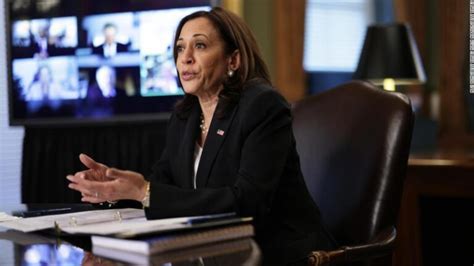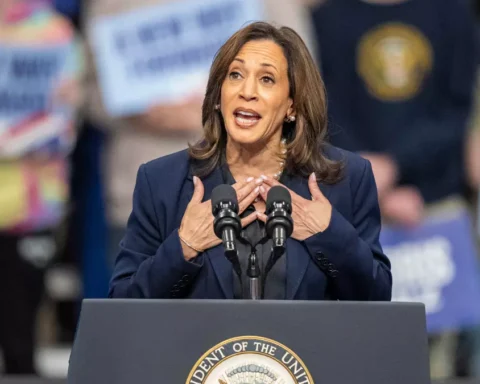In the weeks since the President asked her to take charge of immigration from Central America, Vice President Kamala Harris and her staff have sought to make one thing clear: She does not manage the southern border.
Two White House officials familiar with the dynamic said Harris and her aides have emphasized internally that they want to focus on conditions in Central America that push migrants to the US southern border, as President Joe Biden tasked her to do. A record number of unaccompanied children crossed into the US this spring, and the throngs of desperate minors present a heart-rending problem as well as a political one.
Biden announced Harris’ new assignment on March 24 ahead of an immigration meeting in the White House State Dining Room, telling reporters that he had asked the vice president “because she’s the most qualified person to do it, to lead our efforts with Mexico and the Northern Triangle, and the countries that can help, need help in stemming the movement of so many folks, stemming the migration to our southern border.”
After the announcement, Harris’ aides appeared to “panic,” according to one of the officials, out of concern that her assignment was being mischaracterized and could be politically damaging if she were linked to the border, which at the time was facing a growing number of arrivals. But another White House official pushed back on the sentiment, saying the vice president’s team wasn’t panicked.
One of the officials said Harris appears eager for a portfolio that will allow her to achieve political victories, especially in foreign policy, an area where she is far less experienced than Biden. Instead, Republican critics and the media have portrayed her new immigration role as a border assignment, potentially opening her up to criticism for the handling of the seemingly intractable problem.
Harris’ performance is critical to her future political career, which could well include a run for president. It’s also of special concern right now as she prepares to depart for a trip to Guatemala and Mexico next week as part of this project. It will be her first official foray into in-person, in-country talks about the troubles that push Central American migrants toward the US.
Harris and her staff have made it clear that they want to focus narrowly on diplomatic efforts in Mexico and the Northern Triangle countries of Guatemala, Honduras and El Salvador, where they believe they are more likely to achieve tangible results in addressing the root causes of migration, like economic despair, said the officials.
The recent commitments Harris secured from 12 private companies and organizations to invest in the Northern Triangle are one example.
Harris has conceded that the task assigned to her is a challenging one that won’t be quickly resolved. “We have to give people some sense of hope that if they stay, that help is on the way,” she told CNN’s Dana Bash. “It’s not going to be solved overnight; it’s a complex issue. If this were easy, it would’ve been handled years ago.”
Former and current officials, along with immigration experts, stress that the causes of migration and the surge on the border are inextricably linked and argue that while addressing the reasons people decide to migrate to the US is critical, it can’t be divorced from what’s happening at the US-Mexico border.
“You can’t divorce the border from Mexico or Central America or the interior of the US,” said John Sandweg, a former senior Homeland Security official who served in the Obama administration. “It is all one system.”
“Everything you’re doing in Central America is always towards an eye on the border and what’s happening in the United States,” said Cris Ramon, an immigration consultant. “With the current dynamics in migration, what’s happening at the US-Mexico border has implications in the Northern Triangle and vice versa.”
A White House official told CNN that administration officials regularly brief Harris on the border.
Tens of thousands migrants from Central America arrive at the US-Mexico border monthly. In April, of the 178,622 migrants encountered by US Customs and Border Protection, 79,190, or roughly 44%, were from El Salvador, Guatemala and Honduras, according to the agency’s data, the very countries where Harris is supposed to be addressing migration to the US.
The pandemic has taken a dramatic toll on Latin America, where Covid-19 cases and deaths soared and economies once projected to grow have been decimated. The region was also hit with two devastating hurricanes last year.
The decline in economic growth in 2020, according to the Congressional Research Service, is expected to worsen income inequality and poverty in the region. That, combined with pent-up demands and the perception of the Biden administration being more lenient, has fueled people trying to cross the US-Mexico border.
The Biden administration assigned roles early on to tackle migration, including Roberta S. Jacobson, who was appointed as a special assistant to the President and was a key official dealing with migrants at the US-Mexico border until stepping down in April. The administration also assigned a Northern Triangle special envoy, a position held by Ricardo Zúñiga, who frequently travels to the region.
Harris’ role — which mimics that of Biden under President Barack Obama — is intended to target what’s driving people to the US.
Harris, thought to be a leading Democratic candidate for the 2024 presidential race should Biden not run for reelection, has not shied away from the tough assignment and is engaged and dedicated to her new role, sources told CNN. But she and her staff appeared wary of becoming a scapegoat for Republicans for any and all problems at the southern border — a not-unfounded concern, especially after GOP lawmakers photoshopped her face onto a milk carton and accused her of being “missing” at the border.
The fraught politics is why, immediately after the President announced Harris’ new role, Harris’ aides seemed dismayed when they saw some Republicans and media outlets try to characterize her as the new border czar, said one of the White House officials familiar with the matter. Another White House official said Harris has been focused on the assignment and rejected the notion that her team was concerned about how her role was being perceived.
But following Biden’s announcement, both the President and vice president’s staff clarified repeatedly that Harris would be focused solely on diplomatic efforts to stem the current flow of migrants and develop a larger strategic partnership with Central America.
Harris has stressed that her role is to address the “root causes” of migration beginning in the Northern Triangle countries and Mexico, rather than the “symptoms” of it manifesting at the border, which are being addressed by the Homeland Security secretary. Without a diplomatic push in those countries, “we are just in a perpetual system of only dealing with the symptoms,” she said in April.
Harris’ meetings also indicate where her focus has been. Immigration advocates and regional experts who have participated in roundtables with the vice president describe Harris asking detailed questions on a variety of issues, like agricultural science and water irrigation strategies to tackle food insecurity and infrastructure needs.
Another source familiar with the ongoing discussions on regional strategy said the vice president’s office has been soliciting research on issues, ranging from governance to economic development to climate change, from foundations that study and work in the region.
“She’s asking for a lot of information. … She’s reaching out to a lot of groups to get the best information and to really go in with a sense of who is who and the sense of how can they — the administration — move the agenda,” the source said, adding that prior to a recent meeting with Guatemalan justice sector leaders, the vice president’s team asked for input on what issues to raise with them.
Internally, Harris has been intimately involved in the crafting of a regional strategy, communicating regularly with National Security Council officials. Cabinet members, along with other administration officials, are also putting together proposals on the administration’s root-causes strategy, which Harris is expected to discuss while in Mexico and Guatemala in June, a senior administration official previously told CNN.
“She’ll have to approve this. We’ll brief it to her, she’ll make changes and then once she’s ready to roll it out, that’s what we’re going to do,” the official said.





